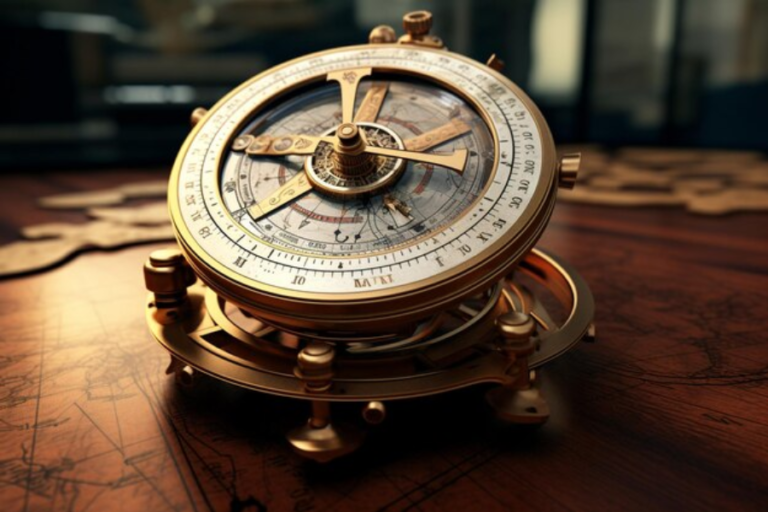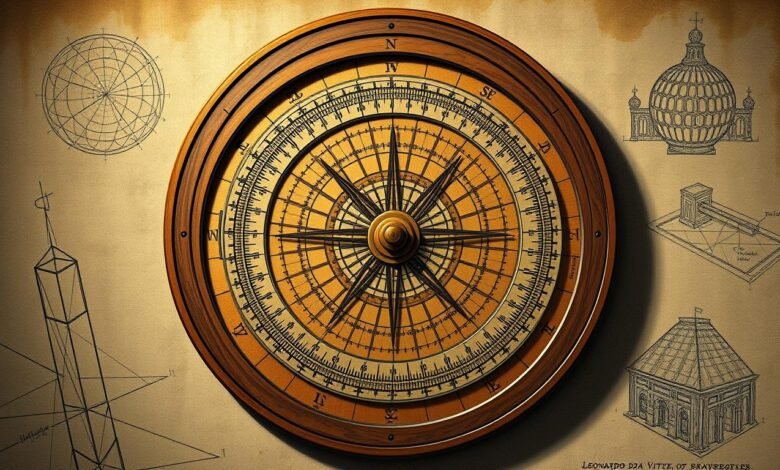Table of Contents
Introduction to the Bussola
Now, try to picture yourself at the intersection of art and science. Creativity meets sharp focus here. This world is closely associated with Leonardo da Vinci, where innovation was not limited. His remarkable invention, the ‘Bussola,’ measured angles within a circle and served multiple purposes. From a Renaissance perspective, it was more than a tool; it was an innovation in navigation and geometry.
Exploring the history of this device, we will find out how Da Vinci’s brilliance reshaped our comprehension of measurements. We will also find out how this modest but potent invention’s intellect advanced contemporary inventions while captivating explorations as we understand them today. Come with me on this time travel to examine the Bussola as a physical instrument and its significance to technological advancements in the past and present!
The History of the Bussola and its Importance in Navigation

Since immemorial, the bussola, or compass, has been and still is helpful for navigation. In the 11th century, the Chinese were the first group to incorporate magnetic compasses, making it easier for ships to travel.
When mariners faced vast uncharted oceans, the bussola was of tremendous help.
It opened up newer navigational possibilities in oceans.
During the Middle Ages, it spread throughout Europe, improving sea travel. True North allowed explorers such as Columbus and Magellan to navigate new lands.
Navigational advancements impacted trade routes and cultural exchanges around the world. Most great voyages in history would have been impossible without this simple yet effective tool.
The Bussola was more functional than a navigational aid; it stood as a testament to humanity’s capability of conquering distance-related challenges.
Leonardo da Vinci’s Contributions to the Design and Accuracy of the Bussola
Da Vinci’s reminiscence on the bussola is astounding. He made an accurate tool from a rough navigation device.
His keen understanding of geometry allowed him to refine the design significantly. By incorporating better materials, he enhanced its durability and accuracy.
Da Vinci didn’t just stop at aesthetics; he meticulously studied angles within circles, improving measurement techniques. This was revolutionary for navigation during his time.
He documented these innovations in sketches that reflected his artistic genius and scientific prowess. His work established guiding fundamental concepts for other inventors to follow.
These efforts helped the Bussola become increasingly dependable, improving navigation and exploration. Da Vinci’s detailed methodology continues to affect today’s world, specifically modern engineering, where his impact is seen in the design and fabrication of precision tools.
How the Bussola Works: Understanding Angles within a Circle
The compass or Bussola has a simple but ingenious working principle: it uses magnetic North to indicate direction.
This instrument allows users to measure angles effectively within a circle.
The needle mechanism accompanying a Bussola follows Earth’s polarity, except that it does not point towards the North. While horizontal, it will direct itself to the true North.
This alignment helps determine angular positions relative to this fixed point.
Understanding how degrees function is pivotal for accurately measuring the angles in a circle. One complete rotation equals 360 degrees. The bustle’s construction is precision-minded, including graduation markings along its perimeter.
Adjusting the device to specific Earth or sky features enables navigators to determine their position relative to the pre-defined coordinates.
This straightforward mechanism has been instrumental throughout history, not only in navigation but also in various fields requiring precision angle measurement.
Modern Uses of the Bussola
Modern society has significantly transformed all its modern technologies, including the bussola, which originated centuries ago during the Renaissance. Even today, this machine is essential in precision measurement and navigation.
For example, experts in architecture have a bussola, which helps estimate the angles when the structures are being designed. This assists in making accurate designs, thus avoiding injury during construction.
This instrument is handy for surveying land limitations. Its capacity to measure angles in a circle permits the formation of accurate layouts and plans.
Outdoor enthusiasts have not been left behind, either. Hikers and campers utilize modern variations of the bussola for orienteering, and a reliable compass keeps them on track through unfamiliar terrain.
Even in education, students learn fundamental concepts of geometry using the bussola as a hands-on tool. It makes understanding angles engaging and interactive.
The development of technology has also seen the emergence of digital models, which, in addition to robotics and automation systems, have further advanced their use in other areas.
The Impact of Da Vinci’s Inventions on Modern Technology
Leonardo da Vinci’s creations profoundly impact contemporary technology today. His visions, hailing from centuries in the future, formed the foundational ideas in numerous domains.
Take aviation as an example. Da Vinci sketched flying machines that inspired future inventors and engineers. The principles he explored are still relevant in today’s aircraft design.
His designs for bridges and mechanical devices in engineering inform contemporary architecture and machinery. Concepts such as gears and levers emerged from his detailed studies.
Da Vinci further impacted the development of observation on a broader scope by affecting the evolution of scientific methodology. He supported the empirical study of matter and accuracy, which are the foundations of modern inventions.
Not only do his complex artworks function as art, but they also aid other innovators in different fields ranging from robotics to anatomy in engineering. Each figure symbolizes an effort of comprehension that continues to alter our world.
Conclusion: Da Vinci’s Legacy in Precision Measurement
Leonardo da Vinci significantly adapted and added to precision measurement, impacting almost every field, from navigation to engineering. With each competency, people began to enjoy the benefits on shed floors as with the bussola. In addition, da Vinci advanced many measuring elements that are taken for granted today. For instance, measuring the sensitive angles on a circle is extremely useful and fundamental in sailing, architecture, and design.
Da Vinci adopted the traits of curiosity and experimentation, which pushed him to transform many aspects of technology. He encouraged future generations of inventors and thinkers to follow in his footsteps and created new ideas on top of his foundational works. Even today, technology is significantly influenced by the ideas developed during the Renaissance period.
The Bussola represents Da Vinci’s brilliance—a simple yet deep tool with exploration and precision at its core, the essence of his being. Today’s navigational tools greatly appreciate his revolutionary imagination on measurement principles.
When considering Da Vinci’s legacy, it’s clear that his impact went further than art or science; it was about shaping a culture rooted in questioning and meticulousness—an attitude still vital in pursuing information.
FAQS
1. What is the bussola used for?
Geometric and navigational calculations in the Renaissance were done with astounding precision thanks to the Bussola, an instrument designed by Leonardo da Vinci that measured angles within a circle.
2. Who invented the bussola for measuring angles?
The Bussola did not originate with Leonardo da Vinci, but he refined its calibrations, overall design, and method for measuring angles within a circle.
3. How did Leonardo da Vinci improve the bussola?
Leonardo da Vinci improved the Bussola to measure angles within a circle, using better materials and more precise angle markings.
4. Why is the bussola important in history?
The Bussola to measure angles within a circle Leonardo da Vinci contributed to changed navigation forever, guiding explorers and shaping world maps.
5. How does the bussola work?
Using the magnetic north and degree markers, Da Vinci’s designed Bussola accurately calculates angles within a circle.
6. Where did Leonardo da Vinci apply the bussola?
The Bussola was employed in circle angle measurement pedagogically in circle geometry and could centroid estimation, which was the focus of Leonardo da Vinci’s work. Its applications include navigation, architecture, and scientific exploration.
7. Is the bussola still used today?
Correct. Even in contemporary approaches to measuring angles within a circle, the principles of the ‘Bussola’ by Leonardo da Vinci remain relevant.
8. What role did the bussola play in navigation?
The Bussola to measure angles within a circle. He improved navigational techniques with da Vinci’s help, which aided sailors wanting to explore the enormous oceans.
9. What distinguishes da Vinci’s bussola from the rest?
Because of its geometric precision and artistic design, the Bussola, which Leonardo da Vinci used to measure angles in a circle, is remarkable amongst the rest.
10. Can students learn geometry with a bussola?
The da Vinci-inspired Bussola cuts deliver effective learning. The device measures angles within a circle and enables an understanding of sharp angle measurement.
